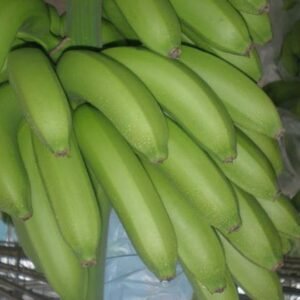Description
Palms have the largest leaves of all trees, and Raphia has the largest leaves of all palms. One species of these monsters is indigenous to South Africa, and that is the majestic Kosi palm.
Description
Tree, often up to 16 m tall, rarely stemless, usually solitary, monoecious (separate male and female flowers on the same tree), monocarpic (flowers once and dies). Leaves pinnate, often very large; petiole unarmed; rhachis with small ascending spines, leaflets reduplicate (central fold up, like an upside-down V), linear, 450-?650 x 50 mm, margin and midrib spiny. The inflorescence (flower spike) is covered by an enormous sheath up to 3m long, which falls away allowing the inflorescence to continue skywards (resembles a floral rocket launch!) Peduncle (flower stalk) covered by 2-ranked, imbricate, gaping bracts; branches and abbreviated flowering branchlets laterally compressed, laxly arranged or congested in one plane; bracts 2-ranked, imbricate. Flowers 2-ranked, female near base; males on upper part of spadix. Male flower with a 2-keeled bracteole; calyx tubular or 3-lobed; petals 3, free or nearly so; stamens 6 to many, free or joined. Female flower with an outer and an inner bracteole and a joined calyx and corolla; staminodial ring joined to corolla; anthers minute or not present; ovary 3-locular, with 1 ovule developing; style short with 3 stigmas or not present. Fruit 1-seeded, ovoid, 60-?90 x 30-?50 mm, covered with brown, imbricate scales arranged in vertical rows, each with a median groove; apex beaked.
Distribution and Habitat
The natural distribution of the Kosi palm is restricted to a small area stretching from just south of Kosi Bay to 40 km or further north of Maputo. The population at Mtunzini is descended from cultivated trees. These trees are found on seasonally inundated dunes, and have pneumatophores (breathing roots) like mangroves.
Derivation of name and historical aspects
Jackson (1990) gives two derivations which are equally plausible:
- the Malagasy word for the fibre derived from the leaves of R. ruffia is rafia, or in English raffia, which could give rise to the generic name
- the name could be derived from the Greek rafis, a needle, referring to the pointed frond. Smith & Stearn (1972) do not mention the first explanation, but say the second refers to the beaked fruit. The specific epithet australis, meaning southern, is highly appropriate to the Kosi palm, southernmost representative of this genus.
The species epiphet australis means southern, not Australian, which is australiensis.
It was only in 1968 that a Kosi palm tree in the Natal Herbarium garden in Durban was seen flowering, and it was realised that this was, in fact, a new species. Until that time it had been thought that the Mtunzini and Kosi Bay trees were the southernmost populations of Raphia vinifera Beauv., a West African species.
There are about 20 species of Raphia, mainly from tropical Africa and Madagascar; one comes from South America, and one is found in southern Africa, straddling the border between KwaZulu-Natal and Mozambique.
The raffia fibre used by gardeners is derived from R. farinifera (Gaertn.) Hyland., a species from tropical Africa and Madagascar, which differs most strikingly from our species in that it suckers. There are also several subtle floral differences separating R. australis from R. farinifera and the West African R. vinifera. A West African raphia holds the record for the largest leaf ever measured, with a rachis over 25 m long.
Ecology
The fruits are an important item in the food supply of the palm-nut vulture. The channelled rachis directs water into the leaf axils, which quickly fill with humus and so become ideal habitats for various epiphytes, mostly ferns and fern allies. Like palms of the genus Caryota (fishtail palms), the Kosi palm flowers once at an age of between 20 and 40 years, and then dies. The seasons do not seem to be of major importance in initiating flowering, but the trigger is unknown. Fruits remain on the tree generally until blown down by high winds, which may only happen a year or two after they are ripe. It seems that in nature, they are mainly dispersed by palm-nut vultures.
Uses and cultural aspects
The palms at Mtunzini station are a declared National Monument, and at least part of the Kosi population is within a nature reserve. Few uses are recorded for this rather rare palm. The raffia fibre of commerce, much used in horticulture, is derived from R. farinifera, although most raffia sold in garden centres today seems to be a plastic imitation. Coates Palgrave (2002) notes that the vast petioles and midribs of the Kosi palm are used in Mozambique to make outriggers for canoes, as they float. WESSA attempted to use them to make footbridges over drainage ditches at Twinstreams, Mtunzini, but found that although they were strong enough to support single pedestrians, they neither supported the groups of enthusiastic teenagers who erected them nor lasted in the soil. However, the pictures accompanying the first scientific description show not only a raft made of Kosi palm, but market stalls and a bus shelter constructed of this material. Obermeyer & Strey (1969) report that unlike some West African species of Raphia, the Kosi palm is not tapped for wine-making. According to Coates Palgrave, craftsmen have converted the midribs and rachises of raffia palm leaves into boutique furniture, which should be possible with the Kosi palm, too. Fruiting spikes of Kosi palm make good, if bulky, ‘African’ ornaments. Kosi palm trees are rarely seen in gardens, and then only in large ones in warm areas.
Delivery: With in one day
Any questions, feel free contact us:








Reviews
There are no reviews yet.